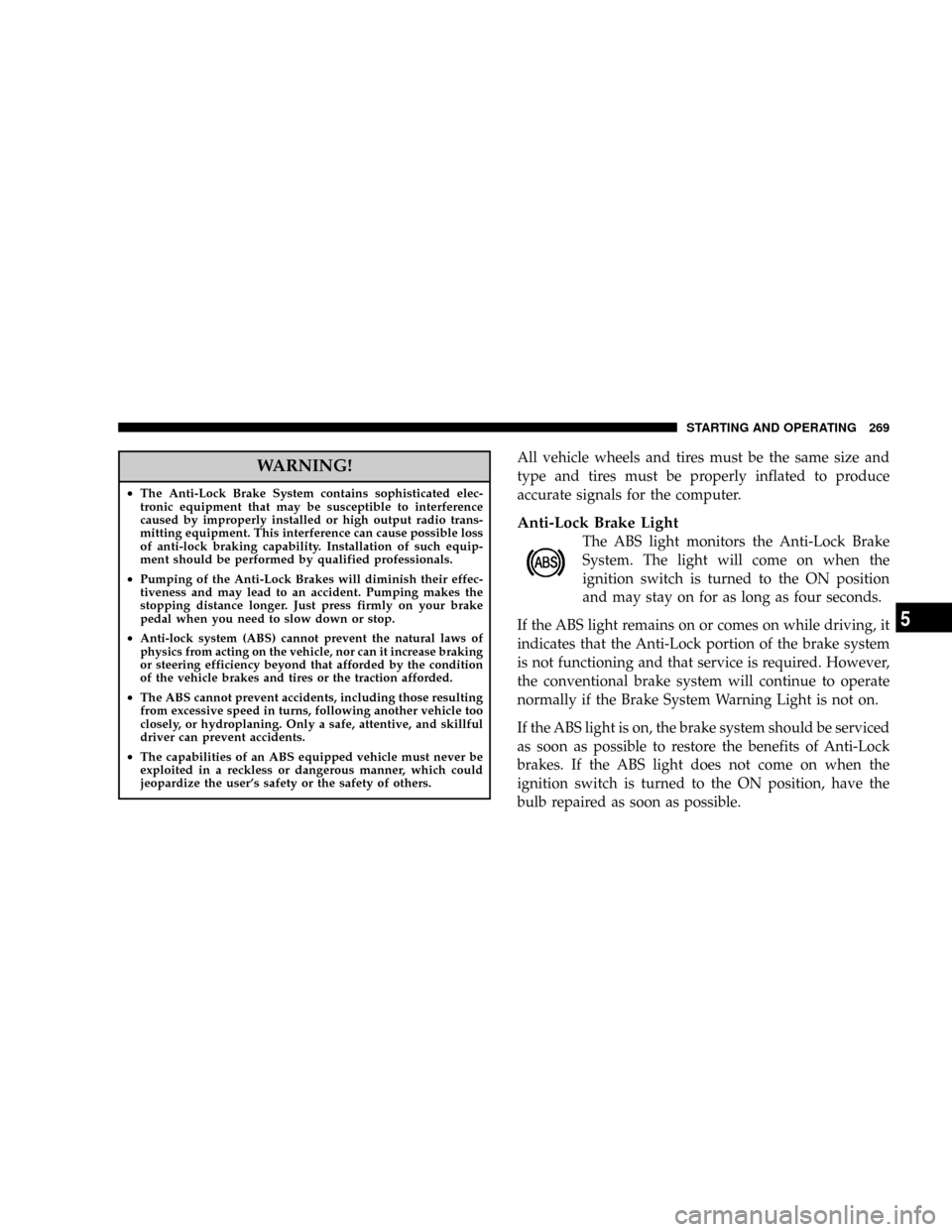CHRYSLER SEBRING CONVERTIBLE 2008 3.G Owners Manual
Manufacturer: CHRYSLER, Model Year: 2008, Model line: SEBRING CONVERTIBLE, Model: CHRYSLER SEBRING CONVERTIBLE 2008 3.GPages: 454, PDF Size: 5.8 MB
Page 261 of 454

occur only to prevent engine overspeed while downshifts
occur earlier than other gear range selections.
CAUTION!
If the transaxle operating temperature exceeds ac-
ceptable limits, the vehicle computer will override
DRIVE (OVERDRIVE) and [5] for 6±Speed
AutoStickttransaxle and [3] for 4±Speed auto trans-
axle, range by changing shift points. This is done to
prevent transaxle damage due to overheating.
Reset Mode - Electronic Transaxle
The transaxle is monitored electronically for abnormal
conditions. If a condition is detected that could cause
damage, the transaxle automatically shifts into 2nd gear
(3rd gear for 6±speed). The transaxle remains in 2nd gear
(3rd gear for 6±speed) despite the forward gear selected.PARK, REVERSE, and NEUTRAL will continue to oper-
ate. This Reset feature allows the vehicle to be driven to
a dealer for service without damaging the transaxle.
In the event of a momentary problem, the transaxle can
be reset to regain all forward gears by performing the
following steps:
1. Stop the vehicle.
2. Shift the gear selector lever into PARK.
3. Turn the ignition switch to the LOCK position.
4. Restart the engine.
5. Shift the gear selector lever into the desired gear range
and resume driving.
STARTING AND OPERATING 261
5
Page 262 of 454

NOTE:Even if the transaxle can be reset, it is recom-
mended that you visit a dealer at your earliest possible
convenience. Your dealer has diagnostic equipment to
determine if the problem could recur.
If the transaxle cannot be reset, dealer service is required.
AUTOSTICKTÐ IF EQUIPPED
AutoSticktis a driver-interactive transaxle that offers six
manual ratio changes to provide you with more control
of the vehicle. AutoSticktallows you to maximize engine
braking, eliminate undesirable upshifts and downshifts,
and improve overall vehicle performance. This system
can also provide you with more control during passing,
city driving, cold slippery conditions, mountain driving,
trailer towing, and many other situations.
AutoSticktSelector Lever
262 STARTING AND OPERATING
Page 263 of 454

AutoStickTOperation
By placing the selector lever one shift-level below the9D9
(Drive) position, it can be moved from side to side. This
allows the driver to select a higher or lower range of
gears. Moving the selector lever to the Left (-) triggers a
downshift and to the Right (+) an upshift. The gear
position will display in the instrument cluster on the
transaxle range indicator.
NOTE:In Autosticktmode, the transaxle will only shift
up or down when the driver moves the selector lever to
the Right (+) or Left (-).
AutoSticktis deactivated when the lever is shifted from
the AutoStick (+/-) position into the Drive ºDº position.
AutoStickTGeneral Information
²
You can start out in first or second gear. The system
will ignore attempts to upshift at too low of a vehicle
speed.
²If a ratio other than 1st is selected, and the vehicle is
brought to a stop, the transaxle control logic will
automatically select the 1st gear ratio.
²Starting out in second gear is helpful in snowy or icy
conditions.
²Avoid using speed control when Autosticktis en-
gaged.
²The transaxle will automatically shift up when maxi-
mum engine speed is reached while Autosticktis
engaged.
STARTING AND OPERATING 263
5
Page 264 of 454

²Transaxle shifting will be more noticeable when
Autosticktis engaged.
²If a low range is selected and the engine accelerates to
the rev limit, the transaxle will automatically select the
next higher ratio.
²If a downshift would cause the engine to over-speed,
that shift will not occur until it is safe for the engine.
Mostly the transaxle will stay in the manually selected
ratio, however:
þIf the system detects powertrain overheating, the
transaxle will revert to the automatic shift mode and
remain in that mode until the powertrain cools off.
þIf the system detects a problem, it will disable the
AutoSticktmode and the transaxle will return to the
automatic mode until the problem is corrected.
PARKING BRAKE
The parking brake should always be applied when the
driver is not in the vehicle.
WARNING!
Never use Park position on an automatic transaxle as
a substitute for the parking brake. Always apply
parking brake fully when parked to guard against
vehicle movement and possible injury or damage.
When parking on a flat surface, place the gear selector
lever in the ªPº (Park) position first, and then apply the
parking brake.
264 STARTING AND OPERATING
Page 265 of 454

When parking on a hill, it is important to apply the
parking brake before placing the gear selector lever in
ªPº (Park), otherwise the load on the transaxle locking
mechanism may make it difficult to move the selector out
of park. As an added precaution, turn the front wheels
toward the curb on a downhill grade and away from the
curb on an uphill grade.
To apply the parking brake, grasp the handle and pull it
upward until you feel resistance. To release the parking
brake, grasp the handle and pull it slightly while pressing
the button on the end of the handle. When the button
drops into the handle (releasing the lock), guide the
handle downward to its stop and then release the button
and the handle.NOTE:
²The parking brake will not release unless the handle is
pulled upward slightly past its applied position.
Parking Brake Lever
STARTING AND OPERATING 265
5
Page 266 of 454

²If the parking brake is applied while the vehicle is
moving, a chime will sound to alert the driver. The
chime will sound up to 10 times or until the vehicle
has returned to a stop.
The Brake System Warning Light in the instru-
ment cluster will turn on when the parking
brake is applied and the ignition switch is on.
NOTE:This light only shows that the parking brake is
applied. It does not show the degree of brake application.
CAUTION!
If the Brake System Warning Light remains on with
the parking brake released, a brake system malfunc-
tion is indicated. Have the brake system serviced by
an authorized dealer immediately.
WARNING!
²Never leave children alone in a vehicle. Leaving
children in a vehicle unattended is dangerous for a
number of reasons. A child or others could be
seriously or fatally injured. Don't leave the keys in
the ignition. A child could operate power win-
dows, other controls, or move the vehicle.
²Be sure the parking brake is fully disengaged
before driving: failure to do so can lead to brake
failure, and an accident.
266 STARTING AND OPERATING
Page 267 of 454

BRAKE SYSTEM
Your vehicle is equipped with dual hydraulic
brake systems. If either of the two hydraulic
systems loses normal capability, the remaining
system will still function. However, there will
be some loss of overall braking effectiveness. This will be
evident by increased pedal travel during application and
greater pedal force required to slow or stop the vehicle. In
addition, if the malfunction is caused by a leak in the
hydraulic system, the brake warning indicator will turn
on as the brake fluid level drops in the master cylinder.
In the event power assist is lost for any reason (i.e.
repeated brake applications with the engine off) the
brakes will still function. However, the effort required to
brake the vehicle will be much greater than that required
with the power system operating.WARNING!
²Riding the brakes can lead to brake failure and
possibly an accident. Driving with your foot rest-
ing or riding on the brake pedal can result in
abnormally high brake temperatures, excessive
lining wear, and possible brake damage. You
wouldn't have your full braking capacity in an
emergency.
²Driving a vehicle with the brake light on is dan-
gerous. A significant decrease in braking perfor-
mance or vehicle stability during braking may
occur. It will take you longer to stop the vehicle or
will make your vehicle harder to control. You
could have an accident. Have the vehicle checked
immediately.
STARTING AND OPERATING 267
5
Page 268 of 454

Anti-Lock Brake System Ð If Equipped
The Anti-Lock Brake System provides increased vehicle
stability and brake performance under most braking
conditions. The system automatically ªpumpsº the
brakes during severe braking conditions to prevent
wheel lock-up.
When the vehicle is driven over 7 mph (11 km/h), you
may also hear a slight clicking sound as well as some
related motor noises. These noises are the system per-
forming its self-check cycle to ensure that the ABS system
is working properly. This self check occurs each time the
vehicle is started and accelerated past 7 mph (11 km/h).
ABS is activated during braking under certain road or
stopping conditions. ABS-inducing conditions can in-
clude ice, snow, gravel, bumps, railroad tracks, loose
debris, or panic stops.You also may experience the following when the brake
system goes into Anti-lock:
²The ABS motor running (it may continue to run for a
short time after the stop).
²A clicking sound of solenoid valves.
²Brake pedal pulsations.
²A slight drop or fall away of the brake pedal at the end
of the stop.
These are all normal characteristics of ABS.
268 STARTING AND OPERATING
Page 269 of 454

WARNING!
²The Anti-Lock Brake System contains sophisticated elec-
tronic equipment that may be susceptible to interference
caused by improperly installed or high output radio trans-
mitting equipment. This interference can cause possible loss
of anti-lock braking capability. Installation of such equip-
ment should be performed by qualified professionals.
²Pumping of the Anti-Lock Brakes will diminish their effec-
tiveness and may lead to an accident. Pumping makes the
stopping distance longer. Just press firmly on your brake
pedal when you need to slow down or stop.
²
Anti-lock system (ABS) cannot prevent the natural laws of
physics from acting on the vehicle, nor can it increase braking
or steering efficiency beyond that afforded by the condition
of the vehicle brakes and tires or the traction afforded.
²The ABS cannot prevent accidents, including those resulting
from excessive speed in turns, following another vehicle too
closely, or hydroplaning. Only a safe, attentive, and skillful
driver can prevent accidents.
²The capabilities of an ABS equipped vehicle must never be
exploited in a reckless or dangerous manner, which could
jeopardize the user's safety or the safety of others.
All vehicle wheels and tires must be the same size and
type and tires must be properly inflated to produce
accurate signals for the computer.
Anti-Lock Brake Light
The ABS light monitors the Anti-Lock Brake
System. The light will come on when the
ignition switch is turned to the ON position
and may stay on for as long as four seconds.
If the ABS light remains on or comes on while driving, it
indicates that the Anti-Lock portion of the brake system
is not functioning and that service is required. However,
the conventional brake system will continue to operate
normally if the Brake System Warning Light is not on.
If the ABS light is on, the brake system should be serviced
as soon as possible to restore the benefits of Anti-Lock
brakes. If the ABS light does not come on when the
ignition switch is turned to the ON position, have the
bulb repaired as soon as possible.
STARTING AND OPERATING 269
5
Page 270 of 454

If both the Brake System Warning Light and the ABS
Light remain on, the Anti-Lock brakes (ABS) and Elec-
tronic Brake Force Distribution (EBD) systems are not
functioning. Immediate repair to the ABS system is
required.
POWER STEERING
The standard power steering system will give you good
vehicle response and increased ease of maneuverability
in tight spaces. The system will provide mechanical
steering capability if power assist is lost.
If for some reason the power assist is interrupted, it will
still be possible to steer your vehicle. Under these condi-
tions, you will observe a substantial increase in steering
effort, especially at very low vehicle speeds and during
parking maneuvers.NOTE:Increased noise levels at the end of the steering
wheel travel are considered normal and do not indicate
that there is a problem with the power steering system.
Upon initial start-up in cold weather, the power steering
pump may make noise for a short amount of time. This is
due to the cold, thick fluid in the steering system. This
noise should be considered normal, and it does not in any
way damage the steering system.
WARNING!
Continued operation with reduced power steering
assist could pose a safety risk to yourself and others.
Service should be obtained as soon as possible.
270 STARTING AND OPERATING